What is Thermoplastic Isolator (TPI)?
Thermoplastic isolators provide optimum support and eliminate pipe contact with the supporting steel.
- Moisture/water can be trapped between the pipe and support, which can initiate corrosion of the pipe
- In addition, when TPI is placed between the pipe and the supporting structural steel, it can prevent cathodic reaction
Iron + Water + Oxygen = Rust ➞ Corrosion
Piping Technology & Products can fabricate TPI designed for use with u-bolts. Our u-bolts, have a hot-dipped galvanized finish and are coated with Polyshrink. The Polyshrink acts as a barrier between the u-bolt and the pipe to prevent corrosion, and it also adds protection.
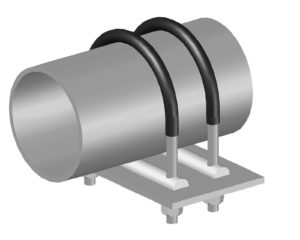 |
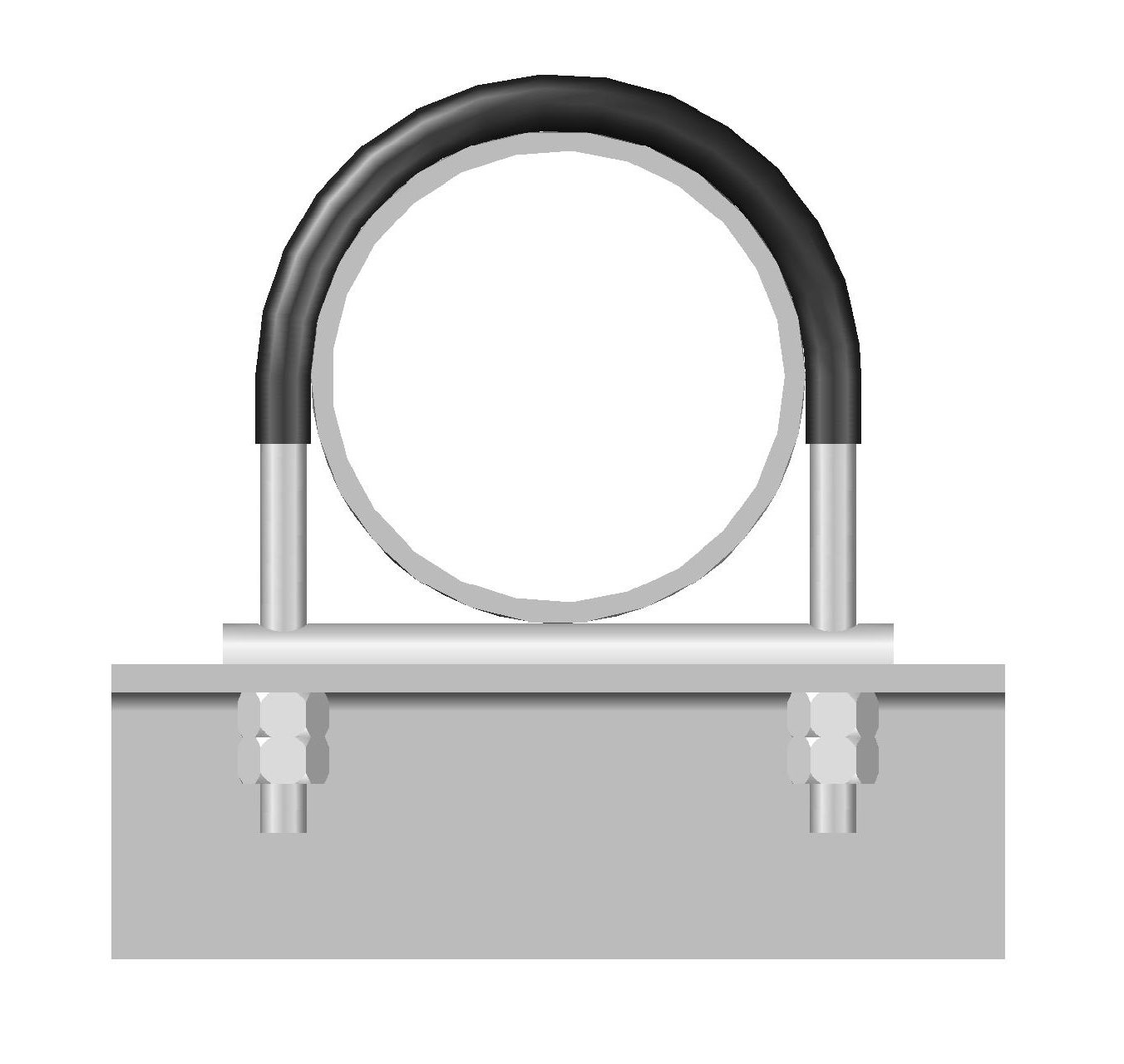 |
Benefits of Thermoplastic Isolator (TPI):
- TPI has a very high compressive strength
- It is subject to very little “creep” over the period of time
- TPI is easy to fabricate
- Cutting and drilling holes can be easily done
- Easy to Install
- Very economical when compared to the leading competitor
- It can be used with different types of pipe supports
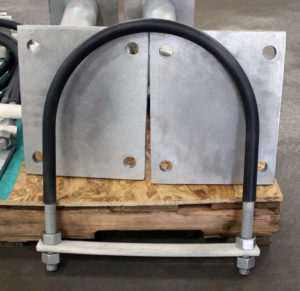
Installation of TPI:
TPI can be placed or attached to structural steel by three different methods.
- Self-tapping screw or bolting
- Double-sided adhesive tape
- With u-bolt
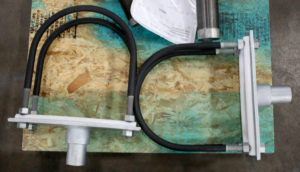
Common Industry Application:
- Petrochemical plants
- Refineries
- LNG plants
- Offshore platforms
- Wastewater plants
- Parking garage
- Marine pipelines
Types of TPI:
There is a total of 3 different types of TPI available based on thermal properties.
- TPI White – Maximum Service Temperature 181°F
- TPI Amber – Maximum Service Temperature 340°F
- TPI Tan – Maximum Service Temperature 480°F
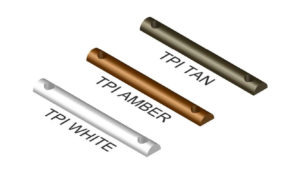
| TPI White | TPI Amber | TPI Tan | ||
| Property Value | ASTM Test | Imperial | Imperial | Imperial |
| Density | D792 | 0.0516 lb/in3 | 0.0458 lb/in3 | 0.047 lb/in3 |
| Tensile Strength | D638 | 11,000 psi | 17,000 psi | 16,000 psi |
| Tensile Modulus of Elasticity | D638 | 450 ksi | 500 ksi | 630 ksi |
| Elongation (At Break) | D638 | 30% | 60% | 40% |
| Flexural Modulus of Elasticity | D790 | 450 ksi | 500 ksi | 600 ksi |
| Flexural Strength | D790 | 13 ksi | 20 ksi | 25 ksi |
| Compressive Stress | D695 | 16 ksi | 22 ksi | 20 ksi |
| Coefficient of Friction | QTM 55007 | 0.25 | 0.42 | 0.32 |
| IZOD Impact (Notched) | D256 | 1 ft-lb/in | 0.5 ft-lb/in | 0.6 ft-lb/in |
| Rockwell Hardness | D785 | M 88 | M 115 | M 105 |
| Maximum Service Temperature | (Long Term) | 181ºF | 340ºF | 480ºF |
| Melting Point | D3418 | 347ºF | 410ºF | 644ºF |
| Coefficient of Linear Expansion | E831 | 47 µin/in/ºF | 31 µin/in/ºF | - |
| Flammability Rating | UL94 | HB | V-0 | V--0 |
| Electric Strength | D149 | 450 V/mil | 830 V/mil | 480 V/mil |
Key Factors in choosing PT&P’s Thermoplastic Isolator over Competitors:
- All suppliers of plastic components for these types of supports, purchase raw materials from some of the same sources
- PT&P’s TPI is equivalent to competitors, but the price of TPI is much lower
- In addition, TPI can be tested in any independent lab
| Property Value | ASTM Test | TPI - White | Competitor |
| Density | D792 | 0.0516 lb/in3 | 0.0509 lb/in3 |
| Tensile Strength | D638 | 11,000 psi | 9,400 psi |
| Tensile Modulus of Elasticity | D638 | 450 ksi | 380 ksi |
| Elongation (At Break) | D638 | 0.3 | 30-60% |
| Flexural Modulus of Elasticity | D790 | 450 ksi | 400 ksi |
| Flexural Strength | D790 | 13 ksi | 13 ksi |
| Compressive Stress | D695 | 16 ksi | 15 ksi |
| Coefficient of Friction | QTM 55007 | 0.25 | 0.25 |
| IZOD Impact (Notched) | D256 | 1 ft-lb/in | 1 ft-lb/in |
| Rockwell Hardness | D785 | M 88 | M 88 |
| Maximum Service Temperature | (Long Term) | 181ºF | 181ºF |
| Melting Point | D3418 | 347ºF | 329ºF |
| Coefficient of Linear Expansion | E831 | 47 µin/in/ºF | 54 µin/in/ºF |
| Heat Deflection Temperature, 264 psi | D648 | 250ºF | 220ºF |
| Flammability Rating | UL94 | HB | HB |
| Electric Strength | D149 | 450 V/mil | 420 V/mil |
| Result from above comparison, both products are equivalent | |||
| Property Value | ASTM Test | TPI – Amber | Competitor |
| Density | D792 | 0.0485 lb/in3 | 0.0462 lb/in3 |
| Tensile Strength | D638 | 17,000 psi | 16,500 psi |
| Tensile Modulus of Elasticity | D638 | 500 ksi | 500 ksi |
| Elongation (At Break) | D638 | 0.6 | 30-60% |
| Flexural Modulus of Elasticity | D790 | 500 ksi | 500 ksi |
| Flexural Strength | D790 | 20 ksi | 20 ksi |
| Compressive Stress | D695 | 22 ksi | 22 ksi |
| Coefficient of Friction | QTM 55007 | 0.42 | 0.42 |
| IZOD Impact (Notched) | D256 | 0.5 ft-lb/in | 0.5 ft-lb/in |
| Rockwell Hardness | D785 | M 115 | M 112 |
| Maximum Service Temperature | (Long Term) | 340ºF | 340ºF |
| Melting Point | D3418 | 410ºF | 410ºF |
| Coefficient of Linear Expansion | E831 | 31 µin/in/ºF | 31 µin/in/ºF |
| Heat Deflection Temperature, 264 psi | D648 | 400ºF | 400ºF |
| Flammability Rating | UL94 | V-0 | V-0 |
| Electric Strength | D149 | 830 V/mil | 830 V/mil |
| Result from above comparison, both products are equivalent. | |||
| Property Value | ASTM Test | TPI - Tan | Competitor |
| Density | D792 | 0.047 lb/in3 | 0.047 lb/in3 |
| Tensile Strength | D638 | 16 ksi | 16 ksi |
| Tensile Modulus of Elasticity | D638 | 630 ksi | 500 ksi |
| Elongation (At Break) | D638 | 0.4 | 0.2 |
| Flexural Modulus of Elasticity | D790 | 600 ksi | 1000 ksi |
| Flexural Strength | D790 | 25 ksi | 25 ksi |
| Compressive Stress | D695 | 20 ksi | 20 ksi |
| Coefficient of Friction | QTM 55007 | 0.32 | 0.4 |
| IZOD Impact (Notched) | D256 | 0.6 ft-lb/in | 1.0 ft-lb/in |
| Rockwell Hardness | D785 | M 105 | M103 |
| Maximum Service temperature | (Long Term) | 480ºF | 480ºF |
| Melting Point | D3418 | 644ºF | 644ºF |
| Coefficient of Linear Expansion | E831 | - | - |
| Heat Deflection Temperature, 264 psi | D648 | 320ºF | 320ºF |
| Flammability Rating | UL94 | V--0 | V--0 |
| Electric Strength | D149 | 480 V/mil- | 480 V/mil- |
| Result from above comparison, both products are equivalent. | |||
